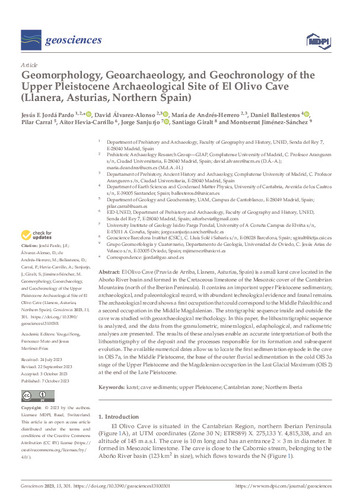Geomorphology, geoarchaeology, and geochronology of the upper pleistocene archaeological site of el olivo cave (Llanera, Asturias, northerSpain)
Publication date:
Publisher version:
Citación:
Abstract:
El Olivo Cave (Pruvia de Arriba, Llanera, Asturias, Spain) is a small karst cave located in the Aboño River basin and formed in the Cretaceous limestone of the Mesozoic cover of the Cantabrian Mountains (north of the Iberian Peninsula). It contains an important upper Pleistocene sedimentary, archaeological, and paleontological record, with abundant technological evidence and faunal remains. The archaeological record shows a first occupation that could correspond to the Middle Paleolithic and a second occupation in the Middle Magdalenian. The stratigraphic sequence inside and outside the cave was studied with geoarchaeological methodology. In this paper, the lithostratigraphic sequence is analyzed, and the data from the granulometric, mineralogical, edaphological, and radiometric analyses are presented. The results of these analyses enable an accurate interpretation of both the lithostratigraphy of the deposit and the processes responsible for its formation and subsequent evolution. The available numerical dates allow us to locate the first sedimentation episode in the cave in OIS 7a, in the Middle Pleistocene, the base of the outer fluvial sedimentation in the cold OIS 3a stage of the Upper Pleistocene and the Magdalenian occupation in the Last Glacial Maximum (OIS 2) at the end of the Late Pleistocene.
El Olivo Cave (Pruvia de Arriba, Llanera, Asturias, Spain) is a small karst cave located in the Aboño River basin and formed in the Cretaceous limestone of the Mesozoic cover of the Cantabrian Mountains (north of the Iberian Peninsula). It contains an important upper Pleistocene sedimentary, archaeological, and paleontological record, with abundant technological evidence and faunal remains. The archaeological record shows a first occupation that could correspond to the Middle Paleolithic and a second occupation in the Middle Magdalenian. The stratigraphic sequence inside and outside the cave was studied with geoarchaeological methodology. In this paper, the lithostratigraphic sequence is analyzed, and the data from the granulometric, mineralogical, edaphological, and radiometric analyses are presented. The results of these analyses enable an accurate interpretation of both the lithostratigraphy of the deposit and the processes responsible for its formation and subsequent evolution. The available numerical dates allow us to locate the first sedimentation episode in the cave in OIS 7a, in the Middle Pleistocene, the base of the outer fluvial sedimentation in the cold OIS 3a stage of the Upper Pleistocene and the Magdalenian occupation in the Last Glacial Maximum (OIS 2) at the end of the Late Pleistocene.
ISSN:
Files in this item





